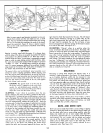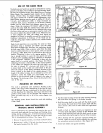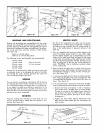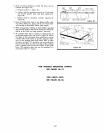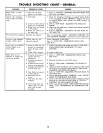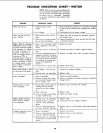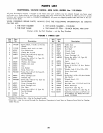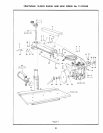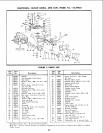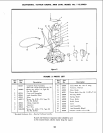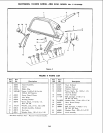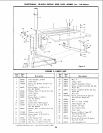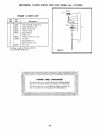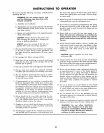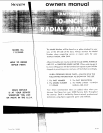
INSTRUCTIONS TO OPERATOR
Be sure to read the following instructions carefully before
operating the saw.
WARNING: Do not connect power cord
until the following steps have been satis-
factorily completed:
a. Assembly and Installation.
b. Examination and operating familiarity with ON-OFF
switch, elevation control, bevel control, rip control,
and miter control.
c. Review and understanding of the operating proce-
dures which follow.
CAUTION: Always disconnect the power cord
when changing the cutting tool, changing the
set-up, or making adjustments.
ALWAYS return the carriage to the full rear
position after each crosscut type operation.
1. The saw should be bolted down if there is any tendency
to tip over or move during normal operations. The
saw table should be approximately 39-inches above
the floor.
2. Set carriage lock before moving machine.
3. Raise front of arm by placing a one-inch thick board
under the two front legs so the carriage will not roll
forward due to gravity.
4. Use only accessories that are designed for this machine.
5. The saw work area should have adequate overhead,
non-glare Jight and adequate surrounding work space.
6. The saw should be positioned when ripping so neither
the operator nor a casual observer is forced to stand
in line with the saw blade.
7. A large proportion of saw accidents is caused by dull,
badly set, improperly filed cutting tools, and by gum
or resin adhering to cutting tools. Such conditions cause
the material to stick, jam, stall the saw, or kick-back at
the operator. Cracked saw blades should be discarded
immediately. A saw blade can become cracked if it
wobbles or if it is not in balance. Avoid potential injury
by proper cutting tool and machine maintenance.
8. Gloves should not be worn while operating the saw.
Loose flowing garments, jewelry (rings, wrist watches,
etc_/, and neckties should never be worn. Long sleeves
should be rolled to above the elbows.
9. Goggles or an eye shield should always be used. Ear
protectors (ear plugs or muffs) should be used during
extended periods of operation.
10. Provide proper support for the workpiece, based on its
size and the type of operation to be performed; hold
11.
12.
13.
14.
15.
16.
17.
18.
19.
the work firmly against the fence. Use a push stick or
board when ripping short work (under 12-inches long),
or narrow work.
Never hang onto or touch the free end of workpiece or
a free piece that is cut off, while power is on.
Do not leave a long board unsupported so the spring
of the board causes it to shift on the table. A support
should be used to catch the end of the board you are
not supporting.
Never climb on or near the saw when power is on.
Never leave the saw with power on, or before the
cutting tool has come to a complete stop. Lock the
motor switch and put away the key when leaving
the saw.
Avoid awkward hand positions, where a sudden slip
could cause a hand to move into a saw blade or other
cutting tool. Never reach in back of or around the
cutting tool with either hand to hold down the
workpiece.
CAUTION: Never reposition the dust chute
with power ON.
Always position the dust chute and the anti-kickback
pawls for rip type operations. Also make sure the cutting
tool, arbor collars and arbor nut are installed properly;
Keep guards in place; use the proper guard.
Do not use any blade or other cutting tool marked for
an operating speed in excess of the design speed of
the saw. Never use a cutting tool larger in diameter
than the diameter for which the saw was designed. For
greatest safety and efficiency when ripping, use the
maximum diameter blade for which the saw is designed,
since under these conditions the spreader is nearest
the blade.
The use of abrasive or cut-off wheels, or wire wheels
can be dangerous and is not recommended. (Abrasive
or cut-off wheels are used to saw many different ma-
terials including metals, stone, and glass.)
Do not position the arm so the operation you are
performing permits the cutting tool to extend beyond
the edges of the table.
Safety isa combination of operator common sense and
alertness at all times when the saw is being used.
WARNING: Do not allow familiarity
(gained from frequent use of your saw)
to become commonplace. Always remem-
ber that a careless fraction of a second is
sufficient to inflict severe injury.
27




